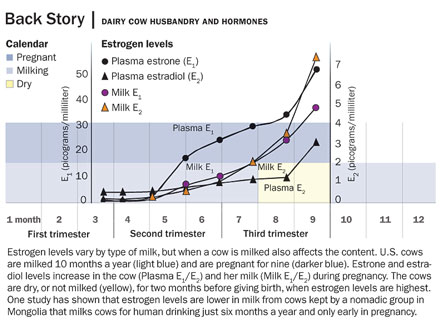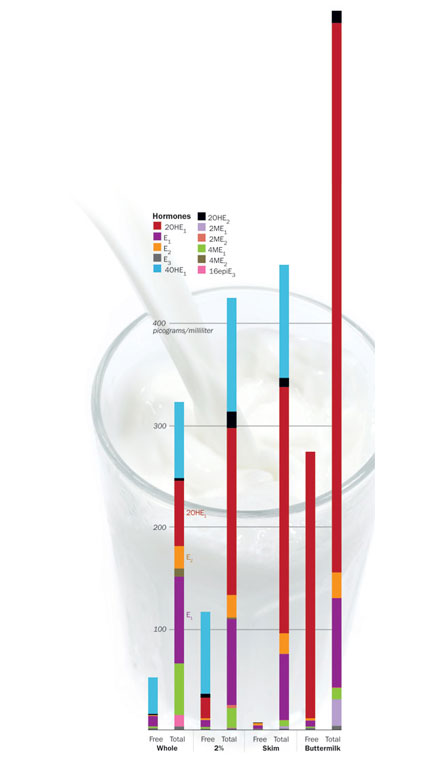Scientists find a soup of suspects while probing milk’s link to cancer
Latest studies focus on estrogens, androgens and IGF-1
Got milk? Adults who answer yes may face a slightly heightened risk of cancer. Some emerging data may help scientists figure out why.


For more than a century, people thought that any beverage safe enough to serve to a weaning child couldn’t hurt an adult. But test-tube studies and studies in adults over the past decade have linked cow’s milk with an excess cancer risk in the prostate, and to a lesser extent in the breast and ovaries, notes oncologist Michael Pollak of McGill University in Montreal. Although scientists seeking to explain the link have fingered some suspects—such as milk’s natural stew of hormones, growth factors and other biologically active chemicals—there’s no “smoking gun,” he says.
But a new study by researchers at the National Cancer Institute at Frederick, in Maryland, offers some ammunition.
Timothy Veenstra and his colleagues assayed grocery-store milk for 15 estrogens: estrone, estradiol and 13 metabolic derivatives of these female sex hormones.
Typically, hormones are produced in the body for use in the body. They act as orchestra conductors, telling genes when to turn on and off. But externally derived hormones add noise.
Estrogens can fuel the growth of many tumors, even in the prostate–and estrogen can do this at amazingly tiny concentrations. Identifying how estrogens’ prevalence varies by milk type, and in what chemical form the hormones occur, required a new assay, which the NCI scientists describe in an upcoming issue of the Journal of Chromatography B.
Using that technique, they showed that the mélange of estrogens varies widely between milks. Whole milk contained the smallest quantity of estrogens, and amounts ascended from 2% to skim and buttermilk. In all of these milks, the majority of estrogens had undergone a minor chemical modification, rendering them less directly bioavailable and less hormonally active.
However, these modified, or conjugated, estrogens are not inert, and they can be converted back to their more potent parent compounds. What’s more, the NCI scientists note, studies by others have shown that relative to free, bioavailable estrogens, conjugated ones take longer to get from the gut into the blood.
Veenstra’s team concludes that compared with free estrogens, milk’s conjugated ones “are likely to have longer half-lives.”
Overall, skim milk had the smallest quantity of free estrogens. However, the conjugated type that dominated skim milk’s profile, 2-hydroxyestrone, is known to be one of the most reactive and potentially risky of the metabolites, notes Xia Xu, a toxicologist on the NCI team. That metabolite’s concentration in fat-free milk was second only to buttermilk’s.
Dermatologist F. William Danby, who teaches at Dartmouth Medical School, also worries about other sex hormones in milk—the “male” androgens.
While estrogens may fuel tumor growth in reproductive tissues, certain androgens—ones that Danby refers to as 5alpha-reduced androgens—“have the capacity for increasing the number of estrogen receptors.” In the January/February Dermato-Endocrinology, Danby notes that milk contains at least one receptor-proliferating androgen: 5alpha-pregnanedione.
Extra receptors, he explains, permit more estrogen—including any from milk—to unlock the cellular machinery that can turn tumor growth on. In other hormone systems, when excess hormone shows up, the body often cuts back on its production. Because the body has had relatively little evolutionary time to adapt to dietary sources of the 5alpha-reduced androgens, Danby says, no such feedback system has evolved.
“And this is probably the most important thing,” he says. Milk-derived hormones “are being poured into a system that didn’t anticipate them”—at least in adulthood.
One of the most provocative aspects of the milk story is its impact on insulinlike growth factor 1. Many studies have linked elevated concentrations of IGF-1 with cancer risk. Not only is milk a rich source of the substance, but people who drink milk also end up with more IGF-1 in their blood.
As with so much in science, however, the IGF-and-milk story is anything but simple, notes David Kleinberg, an endocrinologist at New York University School of Medicine.
Ordinarily, IGF-1 production is turned on when human growth hormone, produced in the pituitary gland, hits certain tissues. IGF-1 becomes the growth hormone’s agent to locally trigger cell growth.
“We showed that IGF-1 can completely take the place of growth hormone” in breast tissue, Kleinberg says. In other words, IGF-1 can trigger cell growth without an outside cue.
Although estrogen is linked to breast development, it’s impotent in the absence of IGF-1. Estrogen can amplify the cell-proliferating effects seen with IGF-1, his team has shown — both in the breast and prostate.
In the February Endocrine Reviews, Kleinberg and his colleagues note that when an excess of IGF-1 or estrogen occurs in the presence of the other, breast hyperplasia occurs—essentially cell division on overdrive.
“And when you get hyperplasia, it can put one at risk for breast cancer. Very slightly at risk,” he says, “like maybe less than a doubling of risk.”
But the real kicker: “There’s a lot of interpersonal variability in our natural production of IGF-1,” Pollak points out. “And even though we are sure that drinking more milk will increase your IGF-1 level, milk’s contribution will still only account for a trivial part of the variation between people.”
Which means genetics trumps milk intake. So people who naturally rank in the top quarter in terms of IGF-1 production and drink no milk, Pollak explains, “will still have a higher IGF-1 level than someone in the low quartile who drinks a quart a day.”
Against this ambiguous backdrop, what’s a milk drinker to do? Because the body of knowledge about this beverage’s human bioactivity is still in its infancy, people may just have to employ the precautionary principle, Pollak says.
“In the absence of definitive [safety] data—or the presence of an adverse effect which may be small—you have to decide: Is there anything good about milk?” And other than developing children and malnourished adults, people probably don’t need milk, he says. “I would never say anything stronger than that.”







